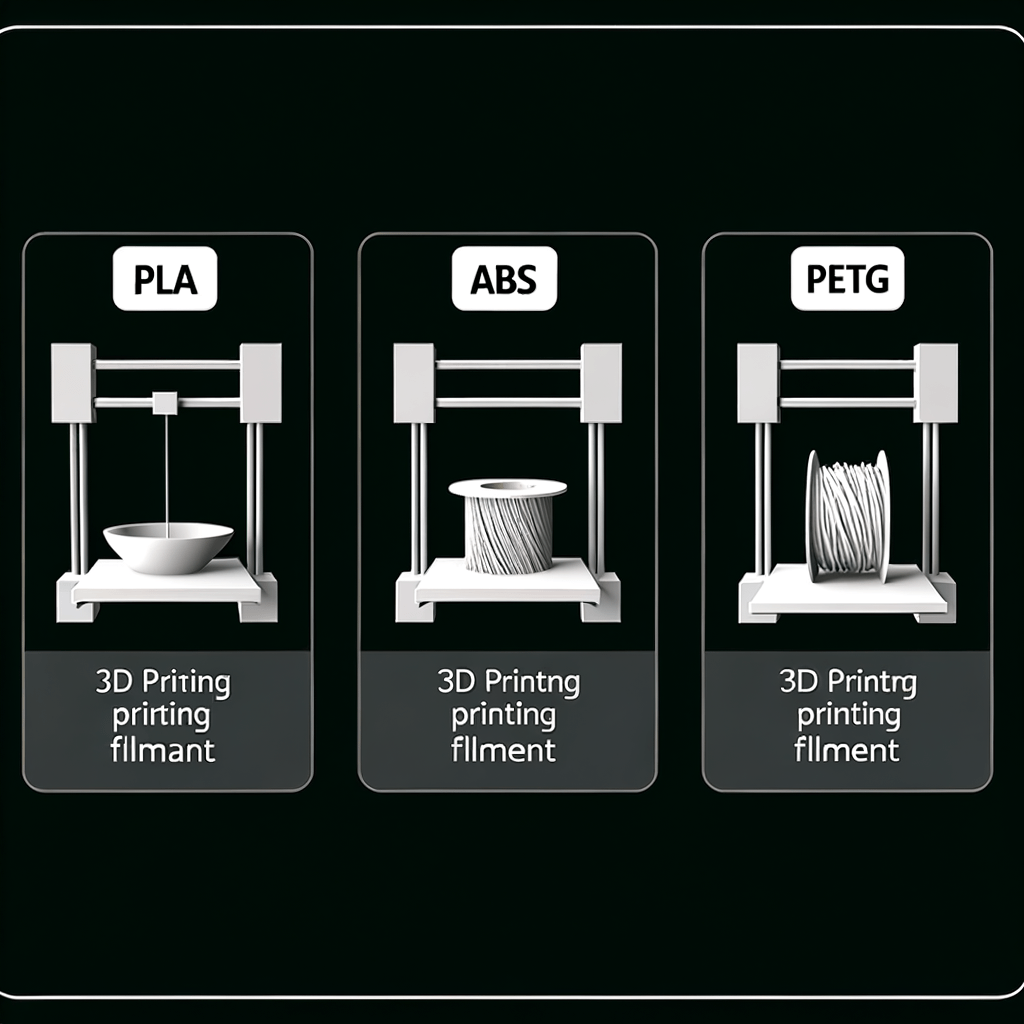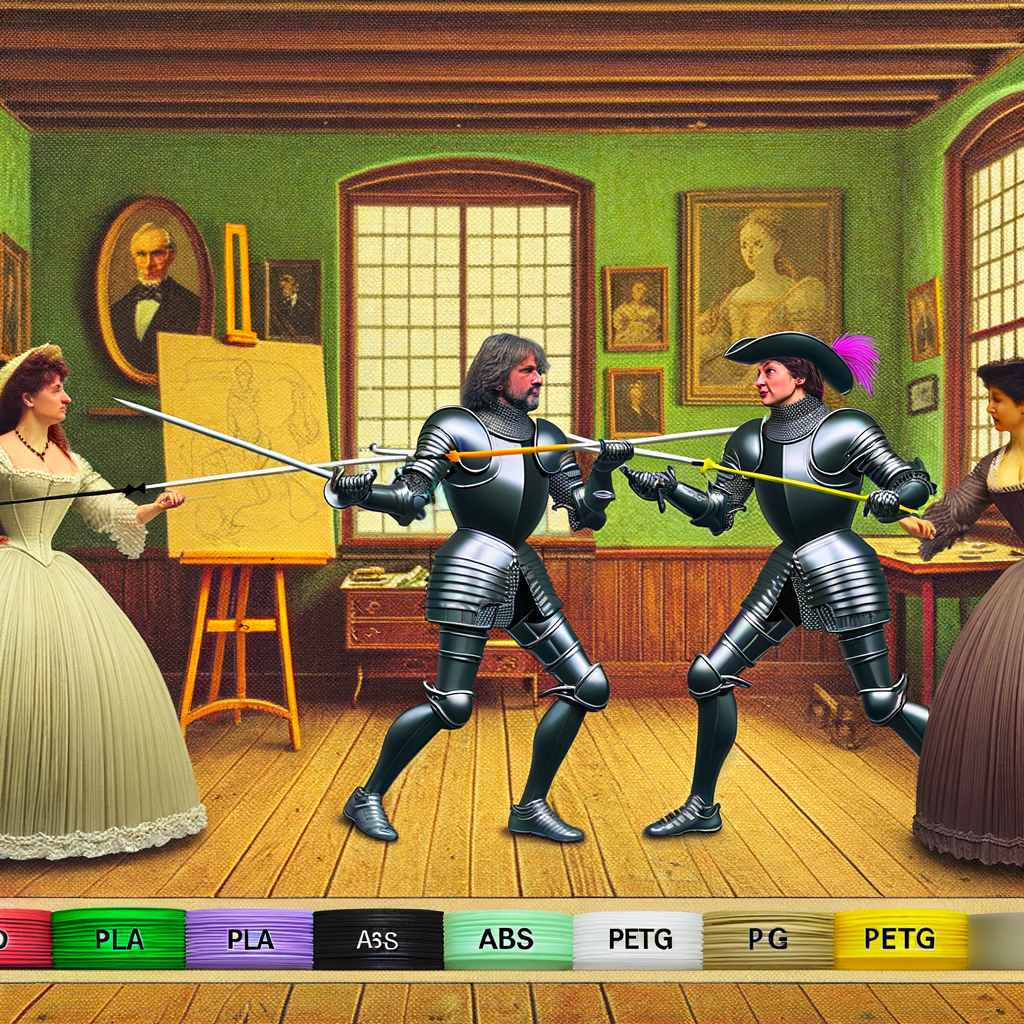Filament Showdown – PLA vs. ABS vs. PETG
Sommario
“Filament Showdown: PLA vs. ABS vs. PETG – Strength, Precision, Versatility. Choose Your Champion!”
Filament Showdown: PLA vs. ABS vs. PETG
In the realm of 3D printing, selecting the right filament material is crucial for achieving the desired properties and quality in printed objects. Among the most popular filament choices are PLA (Polylactic Acid), ABS (Acrylonitrile Butadiene Styrene), and PETG (Polyethylene Terephthalate Glycol-modified). Each of these materials offers a unique set of characteristics that cater to different printing needs and applications. PLA is known for its ease of use and eco-friendliness, ABS for its strength and heat resistance, and PETG for its durability and flexibility. This showdown delves into the comparative analysis of these three filaments, examining their properties, printability, and suitability for various projects to guide users in making an informed decision for their specific 3D printing requirements.
Understanding the Differences: PLA, ABS, and PETG Filament Comparison
Filament Showdown – PLA vs. ABS vs. PETG
In the realm of 3D printing, selecting the appropriate filament is crucial for achieving the desired outcome in printed objects. Among the plethora of materials available, PLA (Polylactic Acid), ABS (Acrylonitrile Butadiene Styrene), and PETG (Polyethylene Terephthalate Glycol) stand out as the most commonly used filaments. Each of these materials boasts unique properties that cater to different applications and user preferences. Understanding the differences between PLA, ABS, and PETG is essential for anyone involved in 3D printing, whether they are hobbyists or professionals.
PLA is a biodegradable thermoplastic derived from renewable resources such as corn starch or sugarcane, making it an environmentally friendly option. It is the most popular filament for beginners due to its ease of use. PLA prints at lower temperatures, typically around 180-220°C, and does not require a heated bed, which simplifies the printing process. Additionally, it emits a pleasant, sweet smell when heated and has minimal warping, reducing the likelihood of print failures. However, PLA’s lower melting point is a double-edged sword; it makes the material unsuitable for high-temperature applications or outdoor use where it can deform on hot days.
Transitioning to ABS, this petroleum-based filament is known for its toughness and impact resistance. ABS is a staple in the manufacturing of various consumer goods, from LEGO bricks to automotive parts. It requires higher extrusion temperatures, usually between 210-250°C, and benefits from a heated print bed to prevent warping. ABS can be smoothed with acetone to achieve a glossy finish, enhancing the aesthetic appeal of the final product. Despite these advantages, ABS poses some challenges. It emits fumes during printing that can be unpleasant and potentially harmful without proper ventilation. Moreover, its propensity to warp makes it less beginner-friendly than PLA.
PETG, a variant of PET (the material commonly used in water bottles), is modified with glycol to reduce brittleness. This filament combines the ease of printing seen in PLA with the strength and temperature resistance closer to ABS. PETG prints at temperatures between 220-250°C and does not require a heated bed, although using one can improve adhesion. It is highly durable, resistant to impact and chemicals, and does not emit harmful fumes, making it a safer choice for indoor printing. PETG’s flexibility and strength make it ideal for functional parts that require a degree of sturdiness without the brittleness of ABS. However, PETG can be prone to stringing and may require fine-tuning of printer settings to achieve the best results.
In conclusion, the choice between PLA, ABS, and PETG depends on the specific requirements of the print job at hand. PLA is the go-to filament for those seeking ease of use and environmental sustainability, while ABS is favored for its strength and finish in more demanding applications. PETG offers a middle ground with its combination of user-friendliness and robustness. Each material has its place in the 3D printing world, and understanding their distinct characteristics enables users to make informed decisions that lead to successful and satisfying printing experiences. As the technology evolves, the nuances of these materials will continue to shape the future of 3D printing, pushing the boundaries of what can be created and how.
The Ultimate Filament Showdown: Pros and Cons of PLA, ABS, and PETG

In the realm of 3D printing, selecting the right filament is crucial for achieving the desired outcome in printed objects. Among the plethora of materials available, PLA (Polylactic Acid), ABS (Acrylonitrile Butadiene Styrene), and PETG (Polyethylene Terephthalate Glycol) stand out as the most commonly used filaments. Each of these materials boasts unique properties that cater to different needs and applications, making the choice between them a filament showdown that requires careful consideration of their respective pros and cons.
PLA is a biodegradable thermoplastic derived from renewable resources like cornstarch or sugarcane, making it an environmentally friendly option. It is the go-to filament for many hobbyists and professionals alike due to its ease of use. PLA prints at lower temperatures, typically around 180-220°C, and does not require a heated bed, which makes it compatible with most 3D printers. Its low warping tendency ensures that models adhere well to the print bed, reducing the likelihood of print failures. Moreover, PLA is available in a wide range of colors and finishes, including transparent, metallic, and glow-in-the-dark, providing a versatile palette for creative projects. However, PLA’s lower melting point is also its Achilles’ heel; it can deform when exposed to high temperatures, limiting its use in applications where heat resistance is essential.
Transitioning to ABS, this petroleum-based filament is known for its toughness and impact resistance. It is the material of choice for printing functional parts that must endure stress and strain, such as gears, automotive components, and protective casings. ABS can withstand higher temperatures than PLA, making it suitable for objects that will be exposed to heat or direct sunlight. However, printing with ABS can be more challenging. It requires higher extrusion temperatures, around 210-250°C, and a heated print bed to minimize warping and ensure proper bed adhesion. Additionally, ABS emits fumes during printing, necessitating good ventilation or an enclosed printing space to safeguard the user’s health.
PETG, a glycol-modified version of PET, the material commonly used in water bottles, strikes a balance between PLA and ABS. It combines the ease of printing seen in PLA with the strength and temperature resistance closer to that of ABS. PETG prints at temperatures between 220-250°C and, while it benefits from a heated bed, it is less prone to warping than ABS, making it more user-friendly. Its resistance to moisture and chemicals makes it ideal for outdoor applications and containers that may hold liquids. PETG also boasts a glossy finish and is less prone to absorbing odors or flavors, which is advantageous for food-related items. However, its stickiness can lead to stringing and blobs if not dialed in correctly, and it may require fine-tuning of printer settings for optimal results.
In conclusion, the ultimate filament showdown between PLA, ABS, and PETG is not about declaring a definitive winner but understanding which material is best suited for a given task. PLA’s biodegradability and ease of use make it perfect for beginners and those looking for a wide range of aesthetic options. ABS’s durability and heat resistance are ideal for functional parts that must endure rigorous use. PETG offers a middle ground with its combination of user-friendliness and robustness, suitable for both aesthetic and functional prints. The choice ultimately hinges on the specific requirements of the print job, the capabilities of the 3D printer, and the user’s expertise. By weighing the pros and cons of each filament, enthusiasts and professionals alike can make informed decisions that lead to successful and satisfying 3D printing experiences.
Choosing the Right 3D Printing Material: A Deep Dive into PLA, ABS, and PETG Performance
Title: Filament Showdown – PLA vs. ABS vs. PETG
Choosing the right 3D printing material is crucial for achieving the desired outcome in any project. Among the plethora of options available, three stand out for their popularity and distinct properties: PLA (Polylactic Acid), ABS (Acrylonitrile Butadiene Styrene), and PETG (Polyethylene Terephthalate Glycol). Each of these materials offers a unique set of characteristics that cater to different needs and applications, making the decision-making process a critical step in the 3D printing workflow.
PLA is often the go-to choice for beginners due to its ease of use and environmentally friendly profile. Derived from renewable resources like cornstarch or sugarcane, PLA is biodegradable under the right conditions. It prints at lower temperatures, typically around 180-220°C, which means it does not require a heated bed, although having one can improve adhesion and reduce warping. PLA’s low printing temperature also minimizes the occurrence of unpleasant odors, making it suitable for use in environments with limited ventilation. However, its lower melting point can be a disadvantage for objects that will be exposed to high temperatures, as they may become deformed or lose structural integrity.
Conversely, ABS is known for its toughness and impact resistance, which makes it a preferred material for functional parts that must endure stress and strain. It is a petroleum-based plastic that prints at higher temperatures, usually between 210-250°C, and requires a heated bed to prevent warping. ABS’s strength comes with a trade-off, as it can emit fumes during printing that may require proper ventilation or filtration to ensure a safe printing environment. Additionally, ABS parts can be post-processed with acetone to achieve a smooth, glossy finish, a feature that is particularly appealing for aesthetic applications.
Transitioning to PETG, this filament combines some of the best features of both PLA and ABS. It offers the ease of printing similar to PLA, with the added benefit of higher temperature resistance and durability akin to ABS. PETG prints at temperatures between 220-250°C and generally does not emit strong odors, making it a user-friendly option for both hobbyists and professionals. It also boasts a higher impact resistance and flexibility compared to PLA, without the warping issues commonly associated with ABS. PETG’s chemical resistance and minimal shrinkage make it an excellent choice for mechanical parts and outdoor applications.
When selecting between PLA, ABS, and PETG, one must consider the end-use of the printed object. For decorative items or prototypes that do not require high strength or temperature resistance, PLA is often sufficient. Its biodegradability also appeals to those seeking a more sustainable option. For parts that need to withstand mechanical loads or higher temperatures, ABS may be the better choice, provided that the printing environment is well-ventilated. Meanwhile, PETG stands out as a versatile middle-ground, offering a balance of ease of use, durability, and resistance to environmental factors.
In conclusion, the decision between PLA, ABS, and PETG should be guided by the specific requirements of the project at hand. Each material presents its own advantages and limitations, and understanding these is key to successful 3D printing. Whether prioritizing ease of use, strength, temperature resistance, or environmental impact, there is a filament that meets the needs of every application. By carefully considering these factors, one can harness the full potential of 3D printing technology and bring even the most intricate designs to life.
Conclusione
Conclusione:
When comparing PLA, ABS, and PETG filaments for 3D printing, each material has distinct advantages and disadvantages that make them suitable for different applications. PLA is biodegradable, easy to print with, and has a low printing temperature, making it ideal for beginners and for objects that don’t require high heat resistance or mechanical strength. ABS is strong, durable, and heat-resistant, suitable for functional parts that need to withstand higher temperatures and stress, but it can be more challenging to print with due to warping and requires a heated bed. PETG combines the ease of printing found in PLA with the strength and heat resistance closer to ABS, offering a good balance for users looking for durability without the difficulty of printing with ABS. Ultimately, the choice between PLA, ABS, and PETG will depend on the specific requirements of the print job, including the desired mechanical properties, aesthetic qualities, and the user’s printing capabilities.




Lascia un commento